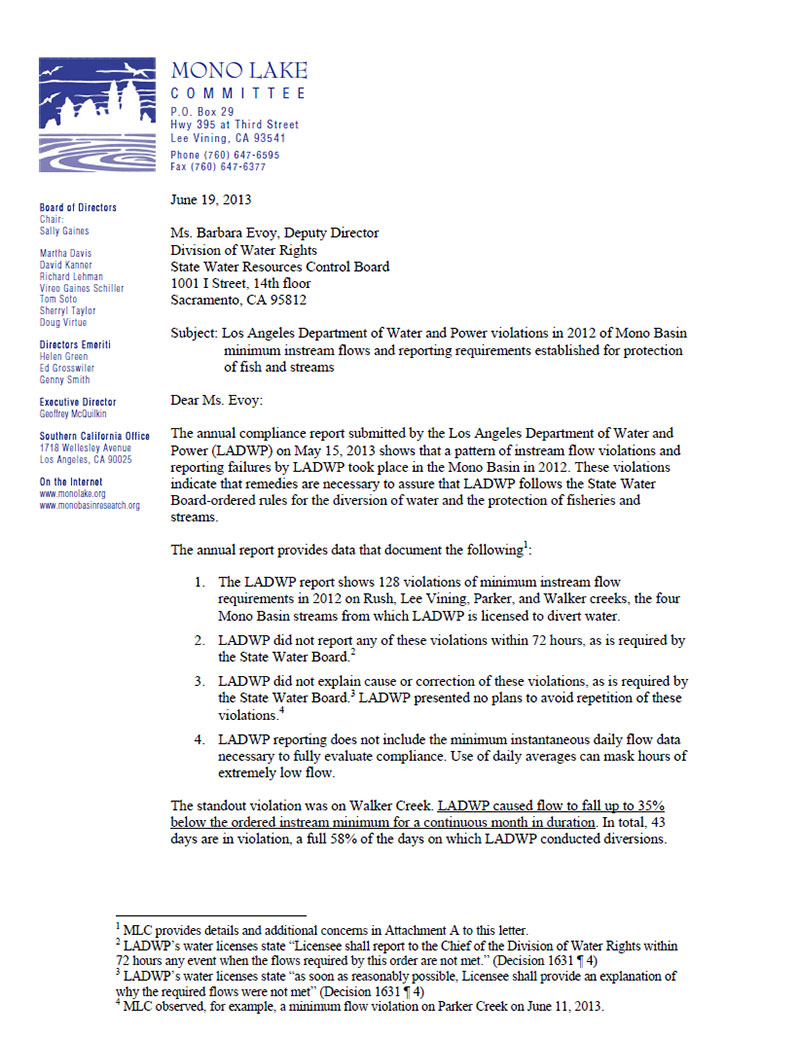
Careful analysis of the Los Angeles Department of Water & Power’s (DWP) May 13, 2013 report to the State Water Board shows a disturbing pattern of streamflow violations and reporting failures in the Mono Basin in 2012. As a watchdog for Mono Lake and its tributary streams, the Mono Lake Committee has submitted this letter to the State Water Board outlining the violations and requesting appropriate action.
Mono Lake Committee Executive Director Geoff McQuilkin said, “The minimum flows in the creeks are required by the California State Water Board to protect fish and stream habitats. DWP needs to keep its promises by following the rules. Otherwise, it’s the creeks that suffer—the fish, the streamside forests, the birds—in these places that people have worked so hard to restore.”
The Committee’s June 19 letter details 128 violations
of minimum streamflows in 2012 on Rush, Lee Vining, Parker, and Walker creeks. The standout violation was on Walker Creek where DWP water diversion operations caused streamflow to fall up to 35% below the ordered minimum for a continuous month in duration. In total, Walker Creek suffered 43 days of flow violation, a full 58% of the days on which DWP conducted diversions.
Significantly, none of the violations were reported within 72 hours, as required by the State Water Board, making it difficult to evaluate specific flow violation impacts.
The compliance report did not explain the cause or any correction of the violations, or plans to avoid them in the future, which is also required by the State Water Board.
The Committee requested that the State Water Board investigate the violations, consider possible fines, halt the most problematic diversion at Walker Creek for now, and require improved reporting.
The Mono Lake Committee is keeping a close eye on this situation in order to protect and restore Mono Lake, and is also pursuing DWP’s Mono Lake monitoring failures documented in the same report. We will post progress on this issue here on The Mono-logue.


And what is the penalty that DWP faces for failing to comply with the State Water Board requirement?
Once again DWP will do whatever they want.
I find this so frustrating. The LADWP seems to be acting with impunity, without concern for not only their ordered obligations but for the health of Mono Lake. I guess this just shows that no matter how much progress is made, if given the chance, LADWP will divert what they please to sate the appetite of its customers regardless of the environmental or legal consequences. I would expect, given the looming 2014 lake-level milestone and the current deficit, that LADWP would make efforts to reduce diversions to below allowable in order to demonstrate a good faith willingness to reach that goal of 6,391. Instead, they’re cheating and Mono Lake suffers.
Larry- the Water Board can issue penalties up to $500/day. See http://www.waterboards.ca.gov/waterrights/water_issues/programs/enforcement/compliance/#enforce
Jeff – This is extremely frustrating, and even moreso when you realize DWP gains no benefit from these violations–for the most part, the amount exported from the Basin remains the same, regardless of the diversion amount from each stream to Grant Lake Reservoir. The violations are purely due to antiquated infrastructure and lack of attention.
And your point about releasing additional water to the lake is a good one, especially when the lake is less than 2 feet above a trigger level that could cut back exports. Keeping Mono Lake high benefits everyone, which is why we are all working together to implement D-1631. The faster the lake gets to 6391, the sooner DWP gets more water export. When the future value of water is compared to the present value, one could reasonably argue that it would be cheaper for DWP to shut off diversions completely in order to reach 6,391 sooner, because the export amount will approximately double once that level is reached, and that future water will be more expensive than water exported today.
Though I am new to the Mono-logue I have followed the lakes status closely.
In the past three years I have covered most of the area surrounding Mono by vehicle and foot recording what the lake has to offer visitors of the lake. My photographs and my concern over the lake are often shown and discussed in San Diego County. Many who view my photographs ask about the lake and how it is doing and the conflicts the LADWP IS inflicting on the growth and health of the Moo Lake. Often guests and visitors to my photographs are intrigued with how the lake is growing after actions the LADWP has taken in the past and now to the lake. Keep up the good work to keep this lake alive for future generations.